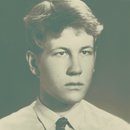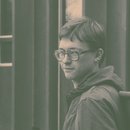This selection is dedicated to the fields of Lithuanian music history, which have not yet been thoroughly researched and documented – namely, the evolution of the electro-acoustic music by academic composers from the late 1970s to this day and experimental creativity in another related niche that might be tagged as ‘instrumental theatre,’ ‘performance art,’ ‘shock art,’ or in other similarly quirky terms.
Unfortunately, it is impossible to begin this selection with the composition, which marks the beginning of electronic music in Lithuania – Kosmosas (Outer Space) composed by Vytautas Bičiūnas (1923–1999) in 1961. The title and the year of composition clearly indicates the first manned spaceflight as its source of inspiration; while the structure and sound, as revealed by contemporary witnesses, was closely modeled on the German electronic compositions of the time, using sine wave generators to produce a sound collage on the cut and spliced magnetic tape. Bičiūnas was better known to many as a musicologist and sound engineer (for decades he had been employed at the sound studio of the Lithuanian Radio and Television and Vilnius Recording Studio of the All-Union Gramophone Record Company Melodiya, which provided him with the only available facilities for experimentation in the field of electronic music) and did not seem to care much about the preservation of his creations (or, at least, about his early experiments). Even if the fact of its existence is supported only by anecdotal evidence provided by the people who knew the composer and heard him demonstrate his pioneering Outer Space, these undocumented testimonies give a reason substantial enough to date the beginning of electronic music in Lithuania from 1961.
Along with electronic and electro-acoustic pieces, our selection also features the soundtracks of ‘instrumental theatre’ pieces, mixed media performances and tape compositions, bearing traces of certain ‘theatrical’ or narrative elements. The upsurge of artistic activity in this field was provoked by the notable liberalization of artistic expression in Lithuania in the second half of the 1980s when the last taboos have been transgressed by staging tantalizing performances that combined music, theatrical action (with the participation of the audience), surrealistic sceneries, aromas, etc. and often involved paradox, absurd and grotesquery. Despite being stripped off their visual and performative elements, the extant soundtracks of these music-theatre pieces may be regarded as eloquent and valuable documents of that period (or, more precisely, of the ‘multidisciplinary’ turn in some composers’ work by the end of the 1980s).
The selection would have been incomplete without the recording of Piano Piece #13 (Carpenter’s Piece) for Nam June Paik by George Maciunas, a Lithuanian born founder of the Fluxus movement. Even though it is not an electro-acoustic composition as such, it may be seen as a remote historical and ideological precursor (however distant in time and space) of the eccentric performances staged by Lithuanian composers at the end of 20th century.
Experimental ventures: from the academy to the
underground
Ilmė Vyšniauskaitė
“Max Ernst, around 1950, speaking at the Arts Club on Eight Street in New York City, said that the significant changes in the arts formerly occurred every three hundred years, whereas now they take place every twenty minutes”[1]. And, apparently, it is difficult to comprehend that with half-a-century behind us and flow of information having zoomed nearly as many times we are still trying to fathom and learn how to take those transformations of the 20th century – reject, negate or discover them anew, invest with meaning and handle by the 21st century standards. But by what measure – minutes, hours, days or years – should we calculate the significant Lithuanian music events that would also reflect the tendencies prevailing in the world?
Electro-acoustic music and experiments in the field of the performance art, created in the second half of the 20th century – first decade of the 21st century, introduced in this collection, would be sufficient to answer this question: the featured works would enable to devise the Lithuanian experimental music canon, which would reveal the aesthetical priorities, criteria, viewpoints, influences and inspirations, imagined ideals and individual notions of electronic creativity. Moreover, we have the possibility to observe how the Lithuanian composers – like Boulezes, Berios, Xenakises or Stockhausens, representing the electronic music ‘elite’ scene and still able to compose traditionally notated string quartet – attempt ‘to escape the academy.’ Thus, the time flow documented in these CDs speaks of common cultural experiences of different generations, vanishing of the things that stood to reason, irony, distorted reality of the Soviet times, music before and after the Independence, before and after Internet. Wish to take a deeper look at the experimental side of the composers’ art prompted to make a thorough study of the context of the adoption of experimental tradition, institutional realm, critical discourse and internet effect on this scene.
In his overview of the history of Lithuanian electronic music, Jurij Dobriakov identifies the coexistence of two separate electronic music scenes in Lithuania: “There are professional, or ‘academic’, composers who pay considerable attention to rational composition and psychoacoustics, and whose experimentation often involves a combination of electronic and acoustic sound, as well as electronically controlled or enhanced acoustic sound. There is also a certain ‘underground’ (this term should be understood, primarily, as indicating the non-institutional character of this group) – quite a wide circle of artists in whose understanding ‘electronic music’ is equated, first of all, with experimental sound art, i.e. with various psychophysical, technical and aesthetic experiments that use electronic sound manipulations as primary means of expression”[2]. Electro-acoustic music narrative introduced in this collection is based on the experiments of composers, thus singular and individual experimental niches represented here were discovered in the same ‘academic’ realm.
When listening to these compositions, one is transferred into an invisible electro-acoustic theatre in which the creative for the composers is not easily graspable parameters but the ones that require deep perception of the context and involvement of both the ear and mind. Perchance a slow penetration of technologies into our music environment determined that the priority was given to the sounds, which could still be tangible and visualised. It seems, that ‘lifeless’ sine-tone electronics is foreign here, thus the voices and instruments often become mediators between the listener and recording. Even though there is no modern electronic music studio in Lithuania to this day, it never was and still is not the only means of technological spreading; the sound technique that existed at the time and as much as it was accessible served as an inspiration for electro-acoustic compositions. There were experiments, which sounded as the affront at the time discussed. Faustas Latėnas’ tape composition Musa memoria (1983), in which one can hear the words of mental patients taken from medicine books, <...> was a protest against the absurdity of daily life and pseudo ideas, an expression of a constrained individual’s frustration. This was regarded as showing off, rather than creative work”[3]. Today this composition sounds as a theatrically modified field recording, concurrently phonographically documenting bygone reality and presenting a collage of something that the generation of the Independence had no experience of.
In the 1960s–70s many of the world’s experimental music representatives were absorbed in deep listening practices (Pauline Oliveros), sound poetry, acoustic ecology, soundscape (Raymond Murray Schafer), sound art, sound walks, field recordings – the phenomena that only in recent decades have found the way into the soundscape projects of Vytautas V. Jurgutis (Metroscan) and Antanas Kučinskas (Lithuanian Soundscapes), electronically deformed sound poetry of Algirdas Martinaitis (The Prayer of the Faithful Word), analogue or digital noise quests of Antanas Jasenka, and sound installations of Arturas Bumšteinas. It turns out, that the field of inspiration for younger generation creators was enriched by newly discovered genres, thus when attributing to this genre the works that belong to the hand of older generations of composers, we feel as if re-writing the history of electro-acoustic music and expanding it with new names and categories, but it is hard to tell whether they represent the spirit of the period.
On the other hand, the fact that such experiments started taking place only in recent decades, illustrates that after Lithuania regained Independence, the artists enjoyed wider opportunities for development, access to recordings of an assortment of music, travels to contemporary music festivals and organising festivals at home. This ‘educational’ artistic aspect becomes especially important when adopting the world’s music tendencies to the local culture. Thus the significance of the festivals grew becoming a realm of education and freedom for the artists themselves, the environment where the creative output of foreign composers, performers, experimental artists influenced the Lithuanian composers, taught young writing musicologists how to talk about contemporary music.
Being confined to a limited group of people, academic art nonetheless encouraged various alternative artistic-musical initiatives, which revealed the tendencies of ‘re-writing’ the music history and identification of their own creative output with non-academic musical or artistic ‘fathers’. This was taking place in both visual arts and music, also resulting in combination of these elements in artistic experiments.
Among these artistic initiatives one should mention the artistic group Green Leaf (the late 1980s)[4]. Members of this group became interested in combination of sound and image, which today is known as sound art. In 1988, its member composer Gintaras Sodeika started organising festivals of happenings (AN-88 and AN-89 in Anykščiai, NI-90 in Nida). Thus, the ‘air was filled’ with fusion of different artistic media as well as close collaboration of the artists of different fields. As an upcoming generation, these artists unanimously sought for novel forms of presenting themselves. Wish to dissociate themselves from Soviet relics and propagated music of the day prompted them to move to untraditional venues and smaller towns. This relocation to ‘peripheries’ could have been the reflection of practical and political motives, but also could have testified the importance of formation of new cultural ‘centres’ in Lithuania. In his address of the interests of Lithuanian composers in the past years, the composer Šarūnas Nakas claims: “The 70s saw formation of several attraction centres. All of them were abroad. Without getting into details, it was Warsaw, Tallinn, Moscow and also Kiev and Riga. Those were the cities that could be reached easily or with more difficulty. Musical life there differed in terms of scale and nature, but the events taking place there were receiving magnified attention”[5]. As regards Lithuania, the formation of new cultural ‘centres’ in the 1980s was restricted due to financial situation, and the search for new venues and performers was swinging according to taste and possibilities of the directors of festivals. Addressing the changing approach to cultural centres Šarūnas Nakas points out that “in the recent decade [1990s] the centres, that were drawing points in the past, partly or totally lost their power of attraction; their role as the stable factor became defunct”[6]. Opening of the borders for easier travelling had its share in this. The aforementioned centres were still active, but they were drowned by the yearning for the new, the need to see and talk about something that was forbidden for those who lived under Soviet regime.
It was the time when various artistic groups started forming. They criticised museum-canons and academic element in art as well as dissociation from society, which also reflects the earlier tendencies in the wider world. In the past Fluxus artists generated similar ideas. In the 1960s–70s the art works for public spaces could be regarded as a certain result of Fluxus ideas, as opposition to traditional system of art, a transformation of settled order and expansion of artistic vocabulary[7]. In the 1980s the Fluxus art and various experiments fascinated Lithuanian composers, which resulted in formation of non-formal musical gatherings and non-institutional festivals offering ‘freer’ and more ironical approach to music creation, as well as encouraging improvisation. “In these festivals, great deal of time was devoted to spontaneous creation and non-conventional arts. The society of that time refused to regard that as art altogether. An idea was suggested: that every man is an artist, but he simply does not know it”[8]. Thus, the performance Piano Piece #13 (Carpenter’s Piece) for Nam June Paik (1962) by the Fluxus ‘father’ George Maciunas, included in this collection, sounds as a tribute to the original inspirations for experimenting coming from the West, but also our compatriot who’s outlook to art and life was so much more radical, than it would have been had he stayed in Soviet Lithuania.
The necessity of experimental music niche was reflected by Tango magazine. Conceived in 1989, its first issue was published in 1990. It was an unprecedented case – unprofessional music researchers started writing about music. Praising different music authorities than was usual in academic music they identified themselves with experimental music practice and considerably transformed notions of creativity. Established on the initiative of Robertas Kundrotas and Linas Vyliaudas the magazine stirred the interest in jazz and free improvisation, avant-garde rock, experimental, electronic and industrial music, allocating place for academic music composers as well. These critical reflections not only familiarised with up-to-date musical practice, but also turned to more radical past tendencies such as futurism or Dada, which also made a great influence on academic composers Šarūnas Nakas and Antanas Jasenka.
It seems, that the urgent importance of this magazine was revised by the emergence of Internet and its public accessibility (around 1997 in Lithuania), which enabled totally different information exchange. It was not necessary anymore to study at an institution of higher education in order to learn about principles of music composition; computer programs facilitated the composing of electronic music at home. Thus, a certain shift in technological thinking might have happened a little after the regaining of the Independence and not only in the creation of academic composers, whose ‘renovation of musical vocabulary’ was expected, but also non-institutional ‘free minded’ artists.
From today’s perspective, this scene of Lithuanian electro-acoustic music does not look manifesting, categorical, utmost shocking or negating the academic music tradition, but rather combining different influences in quest for artistic experiment. The history of experimental music discloses that Lithuanian creators’ electro-acoustic and performance creativity ‘is dependent on’ cosmic fantasies (Jurgis Juozapaitis UFO), electronic ‘glow’ (Osvaldas Balakauskas Heterophony), repetitive use of memorable compositions by other artists (Antanas Kučinskas Nodus finalis), non-verbal telephone signals (Tomas Juzeliūnas Telephonics), machinist motive power (Šarūnas Nakas Merz-machine), longing for the East (Egidija Medekšaitė Panchami), undiscovered sonorities (Vytautas V. Jurgutis Terra tecta), soundscapes (Antanas Jasenka nAJmix’95), deranged speech (Faustas Latėnas Musa memoria), transformed poetry (Algirdas Martinaitis The Prayer of the Faithful Word), gas and oil (Gintaras Sodeika Baza Gaza), audiovisual ‘sights’ (Vidmantas Bartulis Thread), ‘proper’ farewell to the instrument (George Maciunas Piano Piece #13) and many other things.
Translated from the Lithuanian by Sonata Zubovienė
[1] John Cage, “Happy New Ears!”. In: A Year from Monday. Middletown, Connecticut: Wesleyan University Press, 1967, p. 30.
[2] Jurij Dobriakov, “Experimental Electronic Music and Sound Art in Lithuania”. In: Lithuanian Music Link No. 13, 2006 October–2007 March, p. 3.
[3] Asta Pakarklytė, “Faustas Latėnas and His Cheerfully Bitter Music”. In: Lithuanian Music Link No. 13, 2006 October–2007 March, p. 6.
[4] Established in 1988, Green Leaf art students’ group was one of the most active artistic formations in Lithuania. The group made a radical turn from traditionalist art and its ideas rooted in artistic mentality. By adopting some ideas from Dada, Fluxus or futurist art they laid the fundament for ‘their art history’. The group comprised diverse artists: Gediminas Urbonas, Džiugas Katinas, Artūras Makštutis, Aidas Bareikis, Gintaras Sodeika, Julius Ludavičius, Linas Liandzbergis and others. They combined sound and visual dimensions, moved from closed to open venues, to nature.
[5] Šarūnas Nakas, “The Journey Without the Road, for the Mirror Without the Reflection.” In: http://www.modus-radio.com/eseistika/kelione-be-kelio [2012 04 16].
[6] Ibid.
[7] Claudia Tittel, “Sound Art as Sonification, and the Artistic Treatment of Features in our Surroundings”. In: Organised Sound, Vol. 14, Issue 01, Cambrigde University Press, 2009, p. 59–60.
[8] Rūta Gaidamavičiūtė, “On the Margins of Musical Mainstream. A Short History of Fluxus and Experimental Music Theatre in Lithuania”. In: World New Music Magazine No. 18, October 2008, p. 69.






















